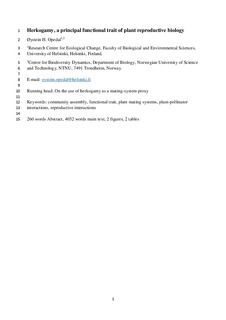| dc.contributor.author | Opedal, Øystein Hjorthol | |
| dc.date.accessioned | 2019-04-16T11:18:43Z | |
| dc.date.available | 2019-04-16T11:18:43Z | |
| dc.date.created | 2018-12-11T10:14:33Z | |
| dc.date.issued | 2018 | |
| dc.identifier.citation | International journal of plant sciences. 2018, 179 (9), 677-687. | nb_NO |
| dc.identifier.issn | 1058-5893 | |
| dc.identifier.uri | http://hdl.handle.net/11250/2594808 | |
| dc.description.abstract | Premise of research. Phenotypic traits that consistently mediate species’ responses to environmental variation (functional traits) provide a promising approach toward generalizing ecological and evolutionary patterns and thereby gaining insights into the processes generating them. In the plant functional ecology literature, most trait-based studies have focused on traits mediating either resource competition or responses to variation in the abiotic environment, while traits mediating reproductive interactions have often been neglected.
Methodology. Here, I discuss the value of herkogamy, the spatial separation of male and female functions in flowers, as a functional trait in plant reproductive biology and review the evidence relevant to the hypothesis that taxa exhibiting greater herkogamy have historically experienced more reliable pollination and more outcrossed mating systems.
Pivotal results. A large body of work in the field of plant reproductive biology has identified a set of nearly ubiquitous correlations between average herkogamy and features of plant mating systems, notably, autofertility (seed set in the absence of pollinators) and outcrossing rate. Herkogamy often varies extensively among populations and species, and the adaptive interpretation is that herkogamy exhibits local adaptation to the reliability of the pollination environment.
Conclusions. These results underline the value of herkogamy as a functional trait representing variation in mating histories. Many important insights are likely to emerge from studies leveraging herkogamy as an easily measured proxy of plant mating systems, as already demonstrated in comparative studies and studies of reproductive interactions. Greater consideration of herkogamy and other reproductive-function traits in studies of species coexistence may provide a more complete understanding of community assembly processes. | nb_NO |
| dc.language.iso | eng | nb_NO |
| dc.publisher | University of Chicago Press | nb_NO |
| dc.title | Herkogamy, a principal functional trait of plant reproductive biology | nb_NO |
| dc.type | Journal article | nb_NO |
| dc.type | Peer reviewed | nb_NO |
| dc.description.version | acceptedVersion | nb_NO |
| dc.source.pagenumber | 677-687 | nb_NO |
| dc.source.volume | 179 | nb_NO |
| dc.source.journal | International journal of plant sciences | nb_NO |
| dc.source.issue | 9 | nb_NO |
| dc.identifier.doi | 10.1086/700314 | |
| dc.identifier.cristin | 1641500 | |
| dc.description.localcode | © 2018. This is the authors’ accepted and refereed manuscript to the article. Locked until 10.oct 2019 due to copyright restrictions. | nb_NO |
| cristin.unitcode | 194,66,10,0 | |
| cristin.unitname | Institutt for biologi | |
| cristin.ispublished | true | |
| cristin.fulltext | postprint | |
| cristin.qualitycode | 1 | |
